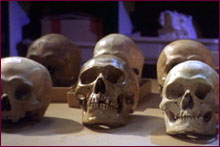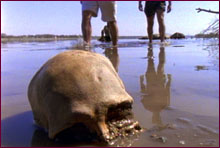
|

|
Dr. Robson Bonnichsen Director, Center for the Study of the First Americans and Professor of Anthropology, Oregon State University The significance of the Kennewick Man discovery should be understood in light of scientific developments occurring in the field of First Americans studies. For more than 40 years, most specialists seeking to explain Paleo-American origins have supported the Clovis-first model. This model proposes that the Americas were peopled once by a biological population from Siberia possessing a single culture and language. It envisions that the founding population moved across the Bering Land Bridge, traveled down the Ice-free Corridor between the Cordilleran and Laurentide ice sheets, and expanded into what is now the United States about 11,500 years ago. By use of a new and efficient hunting technology, these early hunters and gatherers and their immediate descendants were supposedly able to prosper and multiply as they spread across North America and throughout South America in about a thousand years. Many believe that this initial colonization event explains the peopling of the Americas. Over the next 11 millennia, descendants from this initial founding population evolved and were responsible for the enormous diversity of biological populations, cultural groups, and languages found among modern Native Americans at the time of European contact. First Americans specialists are now reconsidering the Clovis-first model in light of new discoveries and scientific developments that suggest the peopling of the Americas is much more complicated than originally anticipated. Many now believe that the old, simple, unilinear evolutionary model is incorrect and that a multilinear evolutionary model that envisions multiple colonization events must replace it. Some specialists are now considering the possibility that different colonizing groups from Asia and possibly Europe are required to account for the biological, cultural, and linguistic diversity found at the time of European contact and in the archeological record. Many specialists believe that the future of First Americans research must focus on exploring the validity of this new paradigm.
Other research suggests a series of regional cultures developed in the Americas that were contemporary with Clovis. For example, the Stemmed Point from the Great Basin, Snake River Plains, and the Plateau as well as the Goshen complex from along the flanks of the Rocky Mountains and Great Plains have radiocarbon ages as early as those from Clovis sites. In summary, the picture that is emerging from the archeological record indicates cultural variability existed in the Americas by Clovis times. Genetic research conducted by Theodore Schurr, Douglas C. Wallace, and others provides compelling evidence for multiple colonization events. Modern Native American populations fall into four mitochondrial DNA haplogroups, A-D, and a fifth founding group is genetically linked to an Eurasian haplogroup X. (Transmitted solely along the female line, mtDNA can help identify individuals to haplogroups, or genetic groupings.) Haplogroups A, C, and D were brought to the Americas perhaps as early as 30,000 years ago. A second immigration may have brought haplogroup B possibly between 13,000 and 17,000 years ago, either along the coast or overland, or both. An additional haplogroup X that shared affinities to European or possibly Eurasian populations may have also entered the Americas prior to the last glacial maximum and is absent in modern Siberian populations. Ancient Beringian populations isolated during the last glacial period evolved by post-glacial times into a large North Pacific Rim branch of haplogroup A, which includes Eskimos and Na-Dene Indians.
Our knowledge of America's earliest biological and cultural heritage remains amazingly thin. For example, there are fewer than 35 dated human skeletal remains in the New World older than 8,000 years old. Most of these early remains are fragmentary. The Kennewick Man skeleton is one of the most complete early skeletons from the Americas, and its study by competent scientists is essential to understanding his morphology, genetics, health, diet, lifestyle, etc., and his relationship to other New and Old World populations. Only through the study of important individual skeletons, such as Kennewick Man, from different regions and different times will the scientific community be able to build a coherent picture of America's past. In First Americans studies, specialists can contribute to the scientific goal of developing an understanding of America's earliest cultural and biological heritage only through the comparative study of archeological remains, human skeletons, and genetics. This research, based on the foundation of integrated studies by multiple independent observers, promises to benefit all peoples by providing knowledge about the diversity of our species, a mirror of our ancestry, and America's contribution to world prehistory. It is imperative that public decision-makers charged with implementing the Native American Graves Protection and Repatriation Act of 1990 recognize the importance of preservation and study of early human remains. Only through scientific study of important discoveries such as Kennewick Man can an objective knowledge America's rich and diverse past be developed and fully appreciated by all communities who have a stake in the past. Does Race Exist? | Meet Kennewick Man Claims for the Remains | The Dating Game | Resources Transcript | Site Map | Mystery of the First Americans Home Editor's Picks | Previous Sites | Join Us/E-mail | TV/Web Schedule About NOVA | Teachers | Site Map | Shop | Jobs | Search | To print PBS Online | NOVA Online | WGBH © | Updated November 2000 |
 Rob Bonnichsen
Rob Bonnichsen
 Many specialists in First Americans studies now
suspect that not one but multiple colonization events
occurred in America's earliest prehistory.
Many specialists in First Americans studies now
suspect that not one but multiple colonization events
occurred in America's earliest prehistory.
 Kennewick Man, whose discovery in a riverbank in 1996
is recreated in this still from the NOVA film "Mystery
of the First Americans," is one of the most complete
early skeletons ever found in the Americas.
Kennewick Man, whose discovery in a riverbank in 1996
is recreated in this still from the NOVA film "Mystery
of the First Americans," is one of the most complete
early skeletons ever found in the Americas.